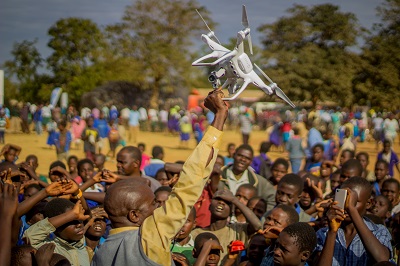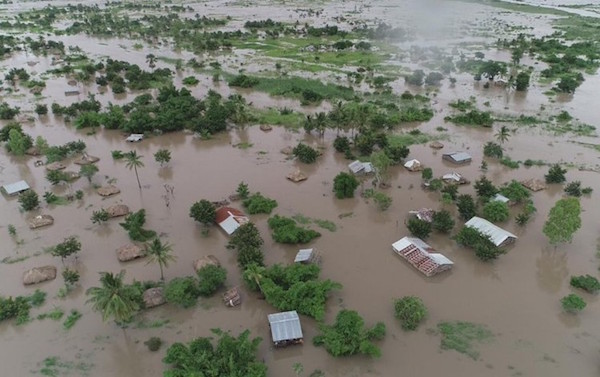unmanned aerial vehicles (UAVs)
See the following -
Africa’s First Humanitarian Drone Testing Corridor Launched in Malawi
 The Government of Malawi and UNICEF today launched an air corridor to test potential humanitarian use of unmanned aerial vehicles (UAVs), also known as drones. The corridor is the first in Africa and one of the first globally with a focus on humanitarian and development use. It is centred on Kasungu Aerodrome, in central Malawi, with a 40km radius (80km diameter) and is designed to provide a controlled platform for the private sector, universities and other partners to explore how UAVs can be used to help deliver services that will benefit communities...
The Government of Malawi and UNICEF today launched an air corridor to test potential humanitarian use of unmanned aerial vehicles (UAVs), also known as drones. The corridor is the first in Africa and one of the first globally with a focus on humanitarian and development use. It is centred on Kasungu Aerodrome, in central Malawi, with a 40km radius (80km diameter) and is designed to provide a controlled platform for the private sector, universities and other partners to explore how UAVs can be used to help deliver services that will benefit communities...
- Login to post comments
Drones and the Future of Disaster Response
 Four continental states and one U.S. territory took a beating this fall as one natural disaster after another rocked communities in Northern California and along the Gulf Coast, spreading disaster relief resources and personnel thin as federal, state, and local governments scrabbled to address the crises. Wildfires in California's wine country claimed at least 42 lives, 8,400 structures, and 245,000 acres of land in October. Hurricanes Harvey and Irma pummeled Louisiana, Texas, and Florida only to be followed by Hurricane Maria, which slammed Puerto Rico on September 20 and left much of the U.S. territory without communications systems, electricity, clean water, or functioning hospitals....
Four continental states and one U.S. territory took a beating this fall as one natural disaster after another rocked communities in Northern California and along the Gulf Coast, spreading disaster relief resources and personnel thin as federal, state, and local governments scrabbled to address the crises. Wildfires in California's wine country claimed at least 42 lives, 8,400 structures, and 245,000 acres of land in October. Hurricanes Harvey and Irma pummeled Louisiana, Texas, and Florida only to be followed by Hurricane Maria, which slammed Puerto Rico on September 20 and left much of the U.S. territory without communications systems, electricity, clean water, or functioning hospitals....
- Login to post comments
Drones Spread Wings From War Zones To Disaster Areas
While lawmakers around the world struggle to keep up with the growth in the use of unmanned aerial vehicles (UAVs) — commonly known as drones — innovation and community participation are changing how this weapon of modern warfare can be used for humanitarian purposes. Read More »
- Login to post comments
How Can Information and Communications Tech Help in Disaster Preparedness and Response?
 n the immediate aftermath of disasters, timely and effective information is critical for the decision-making process. Information and Communication Technologies (ICTs) play a significant role in mitigation, preparedness, response, and rehabilitation by facilitating the flow of vital information in a timely manner. To deliver and deploy telecommunications / information and communication resources (transportable, easy to deploy and reliable systems that are non-exclusive) in a timely manner in the event of disasters, the ITU has designed the ITU Framework for Cooperation in Emergencies (IFCE). Innovative technologies such as robotics, drone technology, GIS, and emerging technologies like artificial intelligence (AI), the Internet of Things (IoT), cloud computing and Big Data are transforming the complex process of disaster management.
n the immediate aftermath of disasters, timely and effective information is critical for the decision-making process. Information and Communication Technologies (ICTs) play a significant role in mitigation, preparedness, response, and rehabilitation by facilitating the flow of vital information in a timely manner. To deliver and deploy telecommunications / information and communication resources (transportable, easy to deploy and reliable systems that are non-exclusive) in a timely manner in the event of disasters, the ITU has designed the ITU Framework for Cooperation in Emergencies (IFCE). Innovative technologies such as robotics, drone technology, GIS, and emerging technologies like artificial intelligence (AI), the Internet of Things (IoT), cloud computing and Big Data are transforming the complex process of disaster management.
- Login to post comments
Open Hardware Groups Spread Across the Globe
 After our group of friends founded a small open hardware community in El Salvador a few years ago, we felt alone in the region. The open hardware movement had developed in a creative explosion of projects and (thanks to the popularization of 3D printing and digital technologies such as Arduino) under a common understanding of how to develop new physical products. The fact that all these people came together so quickly and in so many places at the same time made it harder for people to find each other than it was during the open source software community's development, which found its place within the Linux community and grew through events such as FLISOL in many different Latin American countries...
After our group of friends founded a small open hardware community in El Salvador a few years ago, we felt alone in the region. The open hardware movement had developed in a creative explosion of projects and (thanks to the popularization of 3D printing and digital technologies such as Arduino) under a common understanding of how to develop new physical products. The fact that all these people came together so quickly and in so many places at the same time made it harder for people to find each other than it was during the open source software community's development, which found its place within the Linux community and grew through events such as FLISOL in many different Latin American countries...
- Login to post comments
The Brave New World Of Unmanned Vehicles
While the FAA, other legal and regulatory agencies, and privacy advocates catch up in terms of the legality and ethics o,f such uses of unmanned vehicles, manufacturers are envisioning a future in which UAVs will be a prevalent part of everyday life. "It's going to spark a lot of creativity," said UAV manufacturer Zenon Dragan. Read More »
- Login to post comments
When the United Nations Calls, MicroMappers Acts
 Open source and crowdsourcing—uttering these words at a meeting of the United Nations before the year 2010 would have made you persona non grata. In fact, the fastest way to discredit yourself at any humanitarian meeting just five years ago was to suggest the use of open source software and crowdsourcing in disaster response. Then, a tragic earthquake occured in Haiti in 2010, and OpenStreetMap and Ushahidi were deployed in the aftermath. Their use demonstrated the potential of free and open source crowdsourcing platforms in humanitarian contexts. Then, Typhoon Ruby in the Philippines occured five years later. What technology was used?...
Open source and crowdsourcing—uttering these words at a meeting of the United Nations before the year 2010 would have made you persona non grata. In fact, the fastest way to discredit yourself at any humanitarian meeting just five years ago was to suggest the use of open source software and crowdsourcing in disaster response. Then, a tragic earthquake occured in Haiti in 2010, and OpenStreetMap and Ushahidi were deployed in the aftermath. Their use demonstrated the potential of free and open source crowdsourcing platforms in humanitarian contexts. Then, Typhoon Ruby in the Philippines occured five years later. What technology was used?...
- Login to post comments